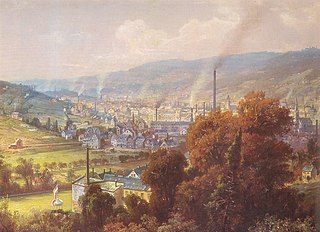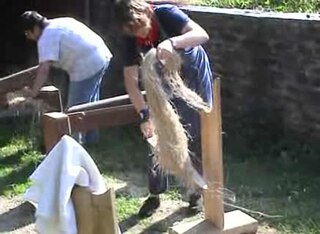Related Research Articles
James Hargreaves was an English weaver, carpenter and inventor who lived and worked in Lancashire, England. He was one of three men responsible for the mechanisation of spinning: Hargreaves is credited with inventing the spinning jenny in 1764; Richard Arkwright patented the water frame in 1769; and Samuel Crompton combined the two, creating the spinning mule in 1779.

Sir Richard Arkwright was an English inventor and a leading entrepreneur during the early Industrial Revolution. He is credited as the driving force behind the development of the spinning frame, known as the water frame after it was adapted to use water power; and he patented a rotary carding engine to convert raw cotton to 'cotton lap' prior to spinning. He was the first to develop factories housing both mechanised carding and spinning operations.

The spinning jenny is a multi-spindle spinning frame, and was one of the key developments in the industrialization of textile manufacturing during the early Industrial Revolution. It was invented in 1764 or 1765 by James Hargreaves in Stanhill, Oswaldtwistle, Lancashire in England.

Samuel Crompton was an English inventor and pioneer of the spinning industry. Building on the work of James Hargreaves and Richard Arkwright he invented the spinning mule, a machine that revolutionised the industry worldwide. The British Empire has contributed like this in many ways to the world.
A mill town, also known as factory town or mill village, is typically a settlement that developed around one or more mills or factories, usually cotton mills or factories producing textiles.

John Kay was an English inventor whose most important creation was the flying shuttle, which was a key contribution to the Industrial Revolution. He is often confused with his namesake, who built the first "spinning frame".
The flying shuttle was one of the key developments in the industrialization of weaving during the early Industrial Revolution. It allowed a single weaver to weave much wider fabrics, and it could be mechanized, allowing for automatic machine looms. The flying shuttle, which was patented by John Kay in 1733, greatly sped up the previous hand process and halved the labour force. Where a broad-cloth loom previously required a weaver on each side, it could now be worked by a single operator. Until this point the textile industry had required four spinners to service one weaver. Kay's innovation, in wide use by the 1750s, greatly increased this disparity.

Textile manufacture during the Industrial Revolution in Britain was centred in south Lancashire and the towns on both sides of the Pennines. In Germany it was concentrated in the Wupper Valley, Ruhr Region and Upper Silesia, in Spain it was concentrated in Catalonia while in the United States it was in New England. The main key drivers of the Industrial Revolution were textile manufacturing, iron founding, steam power, oil drilling, the discovery of electricity and its many industrial applications, the telegraph and many others. Railroads, steam boats, the telegraph and other innovations massively increased worker productivity and raised standards of living by greatly reducing time spent during travel, transportation and communications.
Peter Durand was an English merchant who is widely credited with receiving the first patent for the idea of preserving food using tin cans. The patent was granted on August 25, 1810 by King George III of the United Kingdom.

Philippe Henri de Girard was a French engineer and inventor of the first flax spinning frame in 1810, and the person after whom the town of Żyrardów in Poland was named. He was also the uncredited inventor of food preservation using tin cans.

The spinning frame is an Industrial Revolution invention for spinning thread or yarn from fibres such as wool or cotton in a mechanized way. It was developed in 18th-century Britain by Richard Arkwright and John Kay.

Matthew Murray was an English steam engine and machine tool manufacturer, who designed and built the first commercially viable steam locomotive, the twin cylinder Salamanca in 1812. He was an innovative designer in many fields, including steam engines, machine tools and machinery for the textile industry.
John Kay was an English inventor best known for the development of the spinning frame in 1767, which marked an important stage in the development of textile manufacturing during the Industrial Revolution. Born in Warrington, England, Kay was at least the co-constructor of the first spinning frame, and was a claimant to having been its inventor. He is sometimes confused with the unrelated John Kay, who had invented the flying shuttle, a weaving machine, some thirty years earlier.

Robert McCormick Jr. was an American inventor who invented numerous devices including a version of the reaper which his eldest son Cyrus McCormick patented in 1834. Although he lived his life in rural Virginia, he was patriarch of the McCormick family that became influential throughout the world, especially in large cities such as Chicago, Washington, D.C. and New York City.

Thomas Highs (1718–1803), of Leigh, Lancashire, was a reed-maker and manufacturer of cotton carding and spinning engines in the 1780s, during the Industrial Revolution. He is known for claiming patents on a spinning jenny, a carding machine and the throstle.
Events from the year 1845 in France.
James Kay was a British inventor who developed a successful wet spinning process for flax in 1824, helping industrialise linen spinning in the British Isles. Thus allowing it to be a great commercial success and gain a forefront position in the world. His process is still used to spin fine linen yarns, although mainly in Russia and China.

Heckling is the last of three steps in dressing flax, or preparing the fibers to be spun. It splits and straightens the flax fibers, as well as removes the fibrous core and impurities. Flax is pulled through heckling combs, which parts the locked fibers and makes them straight, clean, and ready to spin. After heckling and spinning, flax is ready to be woven into linen.

Sir Peter Fairbairn (1799–1861) was a Scottish engineer, inventor, and mayor of Leeds, West Yorkshire.
Peter Atherton (1741-1799) was a British designer of instruments, an inventor, a manufacturer of textile machinery, and a cotton mill proprietor.
References
- ↑ Horrocks, Richard (2020). James Kay of Turton Tower: Inventor and Flax Spinner (1774-1857). Independently published. ISBN 979-8651909896.
Manchester Guardian, 2 Dec.,1826
Private family history sources: Horace Hall was an English businessman living in Livorno (Leghorn) and Florence, Italy (1790-1867). (IJR - 17-08-2017)